Experimental and Numerical Study of the Flexural Performance of Spontaneous Combustion Gangue Coarse Aggregate Concrete Laminated Slab
Abstract
1. Introduction
2. Materials and Methods
2.1. Material
2.1.1. Material Properties
2.1.2. Mix Proportions
2.2. Specimen Preparation
2.2.1. Design of Specimens
2.2.2. Preparation of Specimens
2.3. Test Setup and Procedures
2.3.1. Test Setup
2.3.2. Test Procedures
3. Results and Analysis
3.1. Failure Modes
3.2. The Test Results
3.2.1. Load–Deflection Relationship
3.2.2. Load–Reinforcement Strain
3.2.3. Load–Concrete Compressive Strain
3.2.4. Verification of the Plane Section Hypothesis
4. Bearing Capacity Calculation
4.1. Cracking Load
4.2. Ultimate Load
4.3. Crack Calculation
5. ABAQUS Simulation Analysis
5.1. Finite Element Modeling
5.2. Relationship between Stress and Strain of Concrete and Reinforcement in FEM
5.2.1. Concrete
5.2.2. Reinforcement
5.3. Simulation Results
5.3.1. Stress Distribution of Concrete and Truss Reinforcement
5.3.2. Load–Deflection Curve
6. Conclusions
- SCGACLSs went through three phases from the beginning of stress to failure, the elastic working phase, the cracked working phase, and the damaged phase. The failure process, load–strain curve, and load–deflection curve were similar to the ordinary concrete laminated slab. All performances met the requirements of the Chinese standard GB50010 (2010). SCGACLSs can be used as substitutes for the ordinary concrete laminated slab in engineering.
- The slab with a precast layer of SCGAC(C30) and a cast-in-place layer of C30 ordinary concrete showed a 15.2% decrease in cracking load and a 28.3% increase in mid-span deflection in the ultimate condition compared with an ordinary concrete laminated slab. Therefore, the difference between the modulus of elasticity of the precast layer and that of the cast-in-place layer can be reduced by appropriately increasing the strength grade of the precast layer, which can improve the resistance to cracking and make the deformation more cooperative. At the same time, the effect of concrete shrinkage and the bond strength with reinforcement on the bearing capacity of the laminated slab cannot be ignored; this aspect needs to be studied in depth.
- The flexural bearing capacity of SCGACLSs can be calculated approximately by the method in Chinese standard GB50010 (2010); the result had a certain safety reserve, for the calculated deflection value was recommended to be corrected by multiplying the correlation coefficient.
- The finite element simulation results were in good agreement with the test results, the bearing capacity errors were within 5%, the deflection errors were within 10%, and the finite element model established by ABAQUS software could effectively predict the flexural performance of SCGACLSs.
Author Contributions
Funding
Data Availability Statement
Conflicts of Interest
References
- Zhang, Y.; Wang, Q.; Zhou, M. Mechanical properties of concrete with coarse spontaneous combustion gangue aggregate (SCGA): Experimental investigation and prediction methodology. Constr. Build. Mater. 2020, 255, 119337. [Google Scholar] [CrossRef]
- Dong, Z.; Xia, J.; Fan, C. Activity of calcined coal gangue fine aggregate and its effect on the mechanical behavior of cement mortar. Constr. Build. Mater. 2015, 100, 63–69. [Google Scholar] [CrossRef]
- Zhou, M.; Dou, Y.; Zhang, Y. Effects of the variety and content of coal gangue coarse aggregate on the mechanical properties of concrete. Constr. Build. Mater. 2019, 220, 386–395. [Google Scholar] [CrossRef]
- Wang, Q.; Li, Z.; Zhang, Y. Influence of coarse coal gangue aggregates on elastic modulus and drying shrinkage behavior of concrete. J. Build. Eng. 2020, 32, 101748. [Google Scholar] [CrossRef]
- Yang, S.; Zhou, M.; Zhang, Y. Effect of spontaneous combustion gangue coarse aggregate replacement rate on the fracture toughness of concrete. J. Build. Mater. 2020, 23, 858–864. (In Chinese) [Google Scholar] [CrossRef]
- Yao, Z.; Fang, Y.; Kong, W. Experimental study on dynamic mechanical properties of coal gangue concrete. Adv. Mater. Sci. Eng. 2020, 2020, 8874191. [Google Scholar] [CrossRef]
- Wang, Y.; Tan, Y.; Wang, Y. Mechanical properties and chloride permeability of green concrete mixed with fly ash and coal gangue. Constr. Build. Mater. 2020, 233, 117166. [Google Scholar] [CrossRef]
- Querol, X.; Izquierdo, M.; Monfort, E. Environmental characterization of burnt coal gangue banks at Yangquan, Shanxi Province, China. Int. J. Coal Geol. 2008, 75, 93–104. [Google Scholar] [CrossRef]
- Teng, F.; Kan, H.; Zhou, M. Study on bivariate strength formula of spontaneous combustion gangue coarse aggregate concrete. Concrete 2015, 10, 37–39. [Google Scholar] [CrossRef]
- Duan, F.; Ma, A.; Xiao, G.; Yin, H. Research progress on the application of coal gangue in high temperature materials. Silic. Bull. 2013, 32, 1811–1816. (In Chinese) [Google Scholar] [CrossRef]
- Wang, C.; Hu, X.; Jiang, W. Application and research progress of coal gangue in foam insulation ceramics. Jiangxi Build. Mater. 2020, 254, 13–14. (In Chinese) [Google Scholar]
- Wu, X.F.; Zhou, M.; Cui, Z.L. The experiment research on concrete strength influence of spontaneous combustion gangue coarse aggregate. Ind. Constr. 2009, 39, 81–85. (In Chinese) [Google Scholar] [CrossRef]
- Wang, Q.; Zhao, Z.; Liu, Y.; Liu, S. Study on the shrinkage properties of coal gangue concrete. Concrete 2015, 312, 68–70. (In Chinese) [Google Scholar]
- Li, Y.J.; Cao, S.; Xing, Y.; Lei, C. Experimental study on the drying shrinkage performance of coal gangue aggregate concrete. Concrete 2016, 325, 95–97. (In Chinese) [Google Scholar]
- GB/T50082-2009; Standard for Test Methods of Long-term Performance and Durability of Ordinary Concrete. China Architecture & Building Press: Beijing, China, 2009. (In Chinese)
- Li, S.J.; Wang, J.H. Experimental study on the bonding performance of reinforced gangue concrete. J. Shenyang Coll. Constr. Eng. 1990, 006, 18–22. (In Chinese) [Google Scholar]
- Bai, G.; Zhu, C.; Wang, J. Experimental study on the shear performance of gangue concrete beams. J. Build. Struct. 2020, 41, 49–55. (In Chinese) [Google Scholar]
- Li, G.; Chang, C.; Qu, Z.S. Mechanical properties of pressed steel plate-coal gangue concrete composite floor slab. J. Liaoning Univ. Eng. Technol. 2003, 61–63. (In Chinese) [Google Scholar]
- Ma, H.Y.; Da, B.; Yu, H.F. Research on Flexural Behavior of Coral Aggregate Reinforced Concrete Beams. China Ocean. Eng. 2018, 32, 98–109. (In Chinese) [Google Scholar] [CrossRef]
- Wang, B.; Wang, L.; Li, M. Experimental research on the autogenous shrinkage of MK high performance concrete. J. Wuhan Univ. Technol.-Mater Sci. Ed. 2007, 22, 551–554. [Google Scholar] [CrossRef]
- Gao, S.; Zhang, S.; Guo, L. Application of Coal Gangue as a Coarse Aggregate in Green Concrete Production: A Review. Materials 2021, 14, 6803. [Google Scholar] [CrossRef]
- Qanber, A.S.G.; Yas, M.H.; Kadhum, M.M. Numerical and Experimental Behavior Analysis of Slabs Strengthened Using Steel Plates and Slurry-Infiltrated Mat Concrete (SIMCON) Laminates. Infrastructures 2023, 8, 85. [Google Scholar] [CrossRef]
- Jusoh, S.N.; Mohamad, H.; Marto, A.; Yunus, N.M.; Kasim, F. Segment’s joint in precast tunnel lining design. J. Teknol. 2015, 77, 91–98. [Google Scholar] [CrossRef]
- Liu, J.; Wang, B. Experimental study on the flexural performance of monolithic shear walls assembled with mortise and tenon joints under different axial compression ratios. Eng. Mech. 2021, 38, 79–87. [Google Scholar] [CrossRef]
- Namazi, E.; Mohamad, H.; Jorat, M.E.; Hajihassani, M. Investigation on the effects of twin tunnel excavations beneath a road underpass. Electron. J. Geotech. Eng. 2011, 16, 441–450. [Google Scholar]
- GB/T 50010-2010; Code for Design of Concrete Structures. China Architecture & Building Press: Beijing, China, 2010. (In Chinese)
- GB175-2007; Common Portland Cement. Standards Press of China: Beijing, China, 2007. (In Chinese)
- GB/T 14684-2011; Sand for Construction. Standards Press of China: Beijing, China, 2011. (In Chinese)
- GB/T 14685-2011; Pebble and Crushed Stone for Construction. Standards Press of China: Beijing, China, 2011. (In Chinese)
- Zhang, Y.; Xu, Q.; Wang, Q. Axial compressive behavior of circular concrete-filled steel tube stub columns prepared with spontaneous-combustion coal gangue aggregate. J. Build. Eng. 2022, 48, 103987. [Google Scholar] [CrossRef]
- Wang, A.; Zhu, W.; Xu, H.; Liu, K. Research progress of coal gangue aggregates for concrete. Silic. Bull. 2019, 38, 2076–2086. (In Chinese) [Google Scholar]
- Liu, S.; Liu, H.Q.; Wang, J.L. Experimental study on water absorption of concrete with coarse aggregate of spontaneous combustion coal gangue. Nonmet. Min. 2017, 40, 33–35. (In Chinese) [Google Scholar]
- Zhou, M.; Li, G.; Zhang, Q.; Cui, H. Study on the application of spontaneous combustion coal gangue aggregate in ready-mixed concrete. J. Constr. Mater. 2015, 18, 830–835. (In Chinese) [Google Scholar]
- Jiang, Q.; Huang, Q.; Chang, S. Quality management and acceptance of assembled concrete structure projects. Eng. Qual. 2016, 34, 5–13. (In Chinese) [Google Scholar]
- 15G366-1; Reinforced Truss Concrete Composite Slab. China Architecture Standards Design & Research Institute Co., Ltd.: Beijing, China, 2015.
- Wen, X.; Yan, Y. Experimental study on the application of self-combustion gangue as aggregate in construction materials. Concrete 2016, 326, 154–157. (In Chinese) [Google Scholar]
- Chen, Y.; Sun, Q.; Wang, N.; Niu, W. Experimental study of self-combustion gangue concrete. Concrete 2014, 300, 63–65. (In Chinese) [Google Scholar]
- Latour, M.; Daniello, M.; Landolfo, R. Experimental and numerical study of double-skin aluminum foam sandwich panels in bending. Thin-Walled Struct. 2021, 164, 107894. [Google Scholar] [CrossRef]
- GB/T 50152-2012; Standard for Test Methods of Concrete Structures. China Construction Industry Press: Beijing, China, 2012. (In Chinese)
- Colombo, I.G.; Colombo, M.; Di Prisco, M. Bending behavior of Textile Reinforced Concrete sandwich beams. Constr. Build. Mater. 2015, 95, 675–685. [Google Scholar] [CrossRef]
- Idris, Y.; Ozbakkaloglu, T. Flexural behavior of FRP-HSC-steel composite beams. Thin-Walled Struct. 2014, 80, 207–216. [Google Scholar] [CrossRef]
- Falliano, D.; De Domenico, D.; Ricciardi, G. Improving the flexural capacity of extrudable foamed concrete with glass-fiber bidirectional grid reinforcement: An experimental study. Compos. Struct. 2019, 209, 45–59. [Google Scholar] [CrossRef]
- Nana, W.S.A.; Bui, T.T.; Limam, A. Experimental and numerical modeling of shear behavior of full-scale RC slab under concentrated loads. In Structures; Elsevier: Amsterdam, The Netherlands, 2017; Volume 10, pp. 96–116. [Google Scholar] [CrossRef]
- Huang, Z.; Zhao, Y.; Zhang, J. Punching shear behavior of concrete slab reinforced with CFRP grids. In Structures; Elsevier: Amsterdam, The Netherlands, 2020; Volume 26, pp. 617–625. [Google Scholar] [CrossRef]
- Haido, J.H. Flexural behavior of basalt fiber reinforced concrete beams: Finite element simulation with new constitutive relationships. In Structures; Elsevier: Amsterdam, The Netherlands, 2020; Volume 27, pp. 1876–1889. [Google Scholar] [CrossRef]
- Mahdi, S.; Ali, M.S.M.; Sheikh, A.H. An investigation into the feasibility of normal and fiber-reinforced ultra-high performance concrete multi-cell and composite sandwich panels. J. Build. Eng. 2021, 41, 102728. [Google Scholar] [CrossRef]
- Du, H.; Hu, X.; Meng, Y. Study on composite beams with prefabricated steel bar truss concrete slab and demountable shear connectors. Eng. Struct. 2020, 210, 110419. [Google Scholar] [CrossRef]
- Luan, C.; Zhou, M.; Zhou, T. Optimizing the Design Proportion of High-Performance Concrete via UsingResponse Surface Method. Iran. J. Sci. Technol. Trans. Civ. Eng. 2022, 46, 1–15. [Google Scholar] [CrossRef]
- Liu, H.; Xu, Q.; Wang, Q. Prediction of the elastic modulus of concrete with spontaneous combustion and rock coal gangue aggregates. In Structures; Elsevier: Amsterdam, The Netherlands, 2020; Volume 28, pp. 774–785. [Google Scholar] [CrossRef]
- He, D.; Zhang, Z.; Zhang, D. Analysis of ultimate bearing capacity of concrete laminated flexural members. Henan Sci. 2010, 28, 709–712. (In Chinese) [Google Scholar]
- Qiu, J.; Zhu, M.; Zhou, Y. Effect and mechanism of coal gangue concrete modification by fly ash. Constr. Build. Mater. 2021, 294, 123563. [Google Scholar] [CrossRef]
- Zeng, M.; Chen, W.; Su, Q. Analysis of shrinkage self-stress in precast combined box girder section concrete. Struct. Eng. 2015, 31, 41–48. (In Chinese) [Google Scholar]
- Khalid Heiza, A.N.; Meleka, N.; Tayel, M. State-of-the art review: Strengthening of reinforced concrete structures–different strengthening techniques. In Proceedings of the Sixth International Conference on Nano-Technology in Construction, Asyut, Egypt, 22–24 March 2014; Volume 6, pp. 22–24. [Google Scholar]
- Wu, F.; Huang, H.; Chen, W. Experimental study on the force performance of prefabricated ribbed thin concrete laminated slab members. Civ. Constr. Environ. Eng. 2011, 33, 7–12, 19. (In Chinese) [Google Scholar]
- Belardi, V.G.; Fanelli, P.; Vivio, F. Structural analysis of transversally loaded quasi-isotropic rectilinear orthotropic composite circular plates with Galerkin method. Procedia Struct. Integr. 2018, 8, 368–378. [Google Scholar] [CrossRef]
- Belardi, V.G.; Fanelli, P.; Vivio, F. Bending analysis with Galerkin method of rectilinear orthotropic composite circular plates subject to transversal load. Compos. Part B Eng. 2018, 140, 250–259. [Google Scholar] [CrossRef]
- Kabir, H.; Aghdam, M.M. A robust Bézier-based solution for nonlinear vibration and post-buckling of random checkerboard graphene nano-platelets reinforced composite beams. Compos. Struct. 2019, 212, 184–198. [Google Scholar] [CrossRef]
- Ukanwa, K.; Mohamad, N.; Lim, J.B.P. Computational finite element modeling of structural behaviors of precast sandwiched foamed concrete slab. Open J. Civ. Eng. 2015, 5, 220. [Google Scholar] [CrossRef]
- Tian, J.; Wang, M. Experimental and numerical study of continuous span concrete composite slabs. In Structures; Elsevier: Amsterdam, The Netherlands, 2021; Volume 34, pp. 827–839. [Google Scholar] [CrossRef]
- Shafieifar, M.; Farzad, M.; Azizinamini, A. Experimental and numerical study on mechanical properties of Ultra-High-Performance Concrete (UHPC). Constr. Build. Mater. 2017, 156, 402–411. [Google Scholar] [CrossRef]
- Guo, Z.; Shi, X. Principles and Analysis of Reinforced Concrete; Tsinghua University Press: Beijing, China, 2003; pp. 2–21. [Google Scholar]
- Cai, Q.; Lin, X.F.; Yu, G.Q. Influence of detection location on the accuracy of heat transfer coefficient identification of walls by McQuart method. Wall Mater. Innov. Build. Energy Effic. 2014, 185, 58–61. (In Chinese) [Google Scholar]
- Katwal, U.; Tao, Z.; Hassan, M.K. Finite element modeling of steel-concrete composite beams with profiled steel sheeting. J. Constr. Steel Res. 2018, 146, 1–15. [Google Scholar] [CrossRef]
- Rehman, A.; Masood, A.; Akhtar, S. Experimental and numerical investigation into flexural bond strength of RC beams exposed to elevated temperature. Constr. Build. Mater. 2021, 282, 122630. [Google Scholar] [CrossRef]
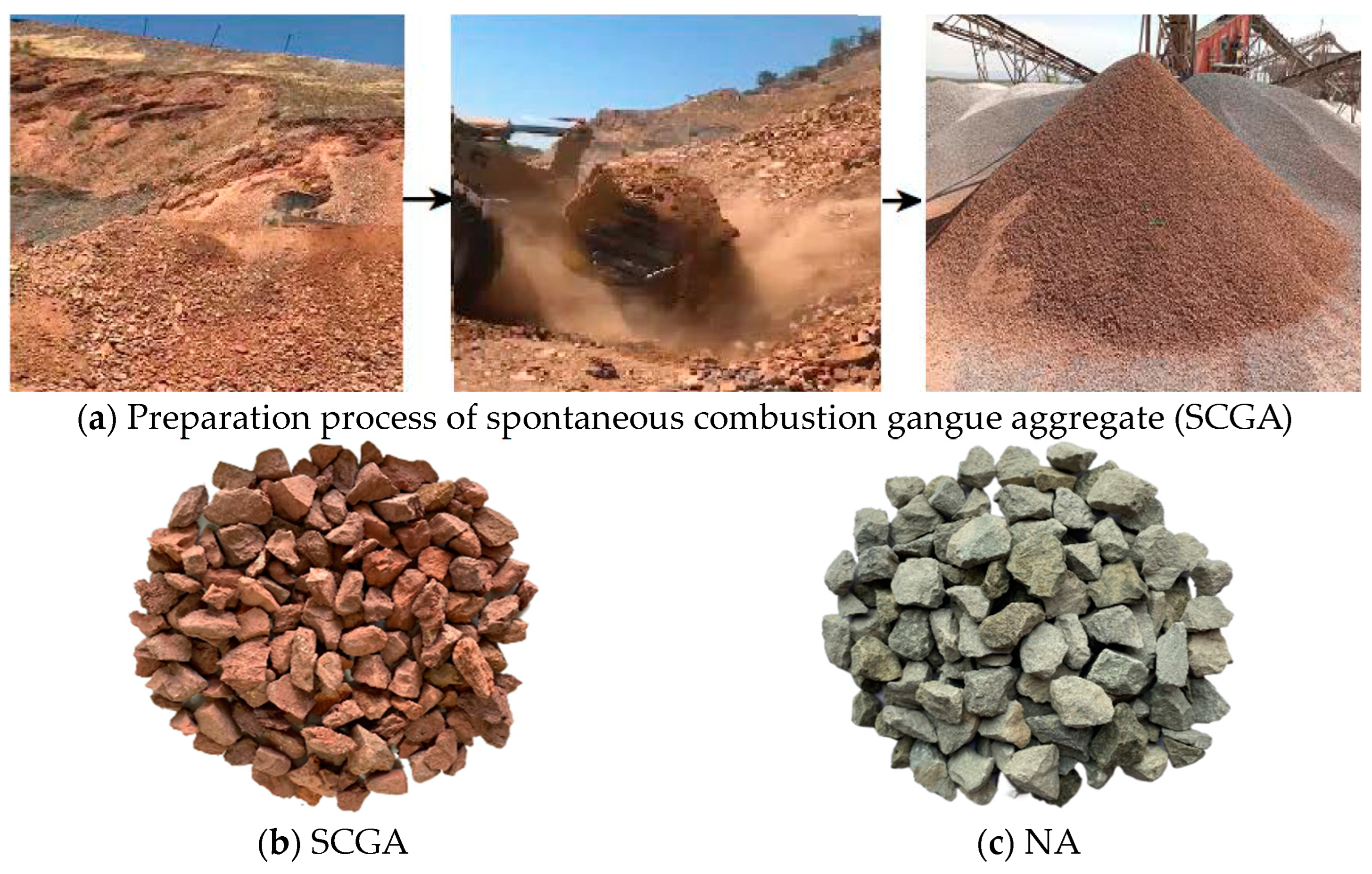
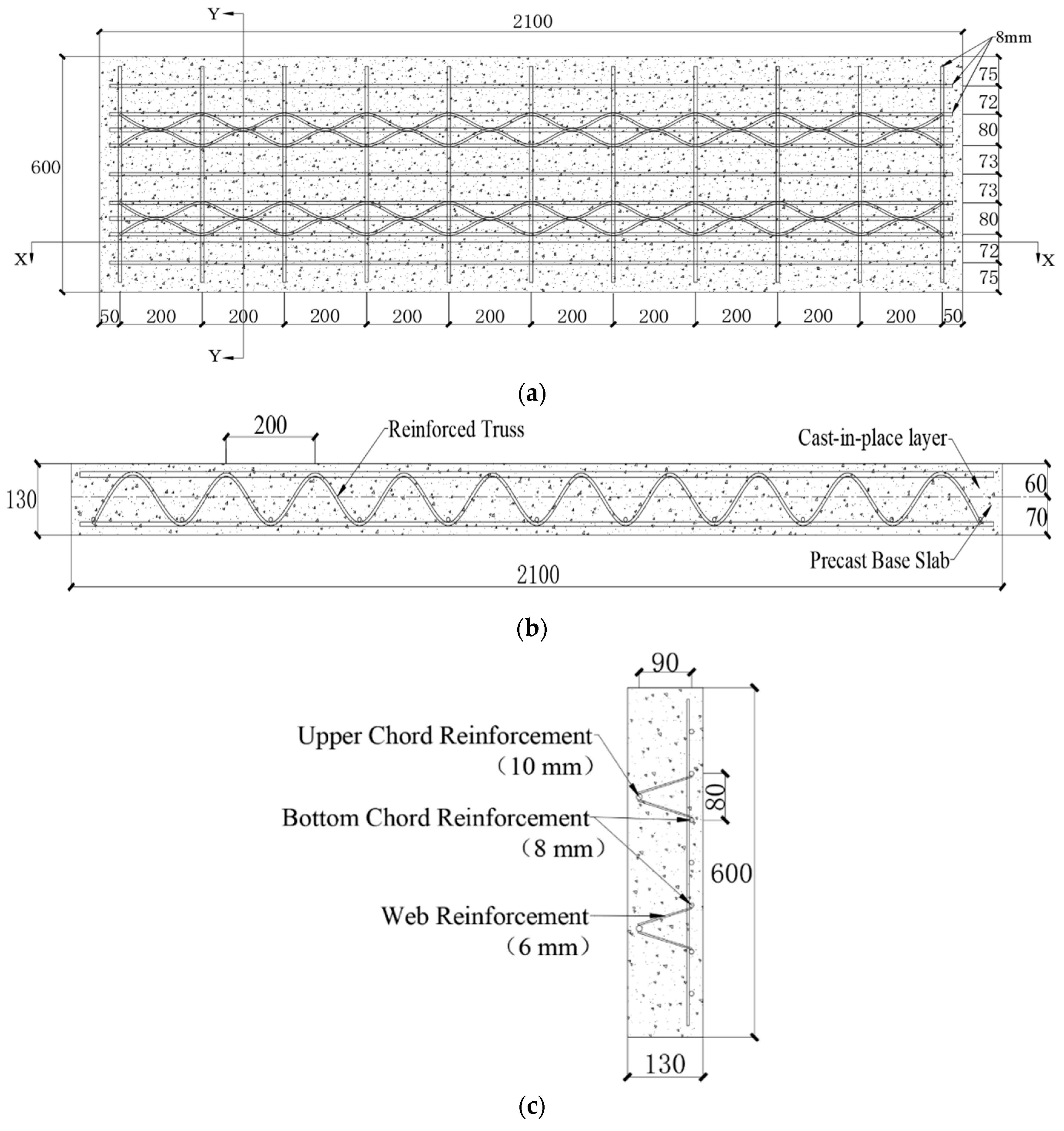
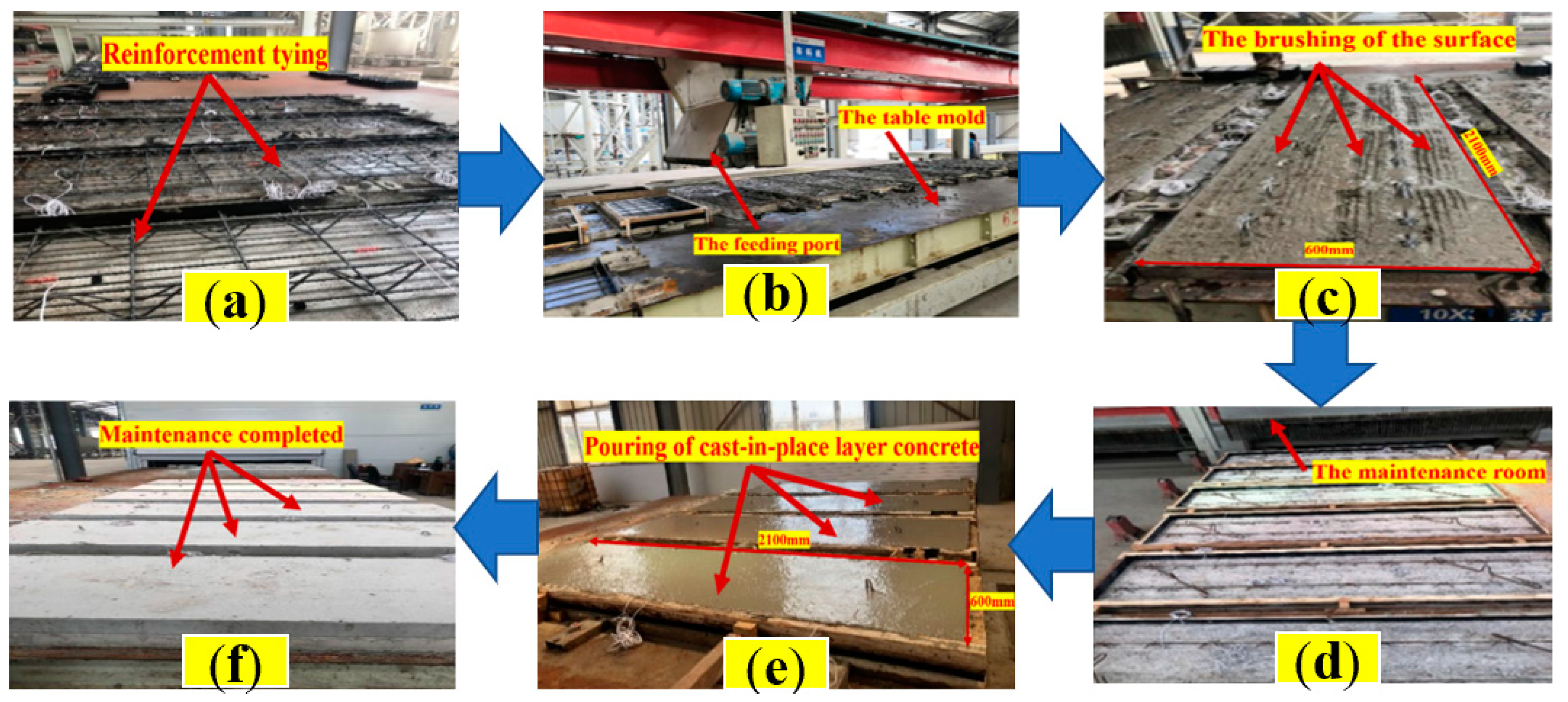

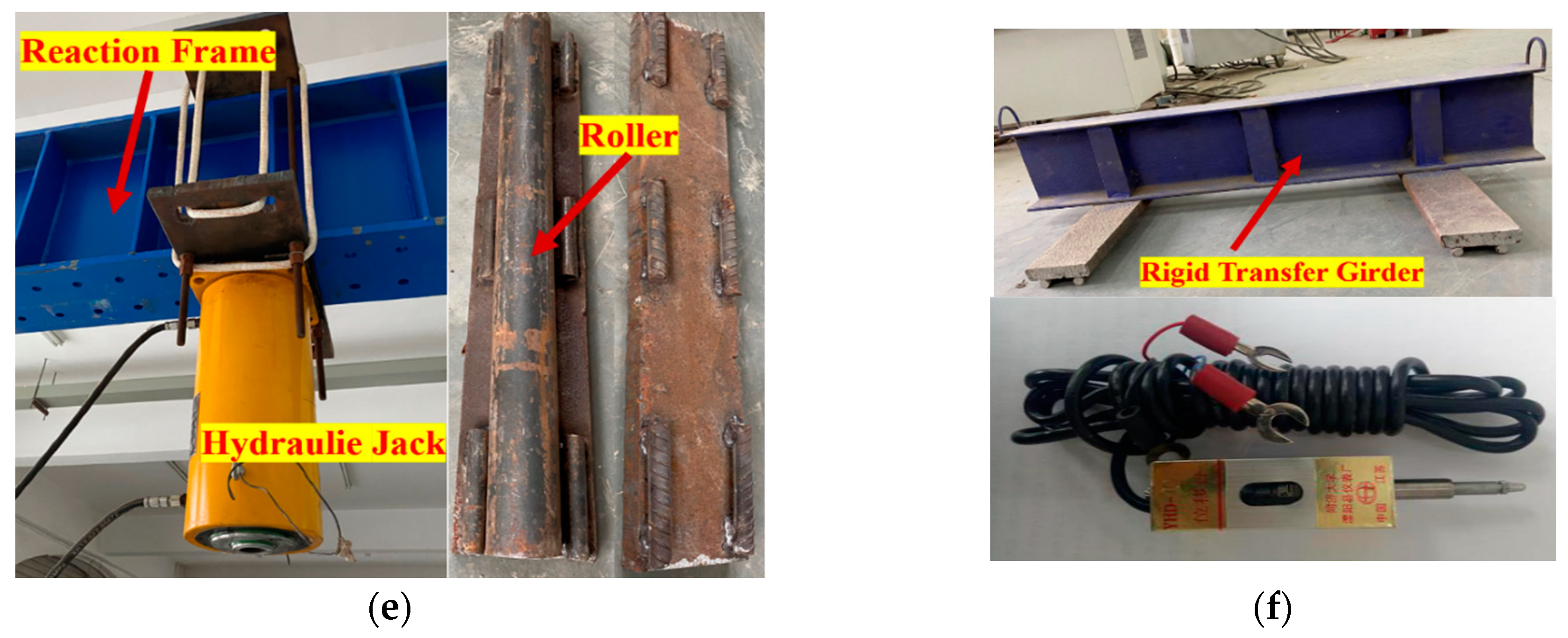

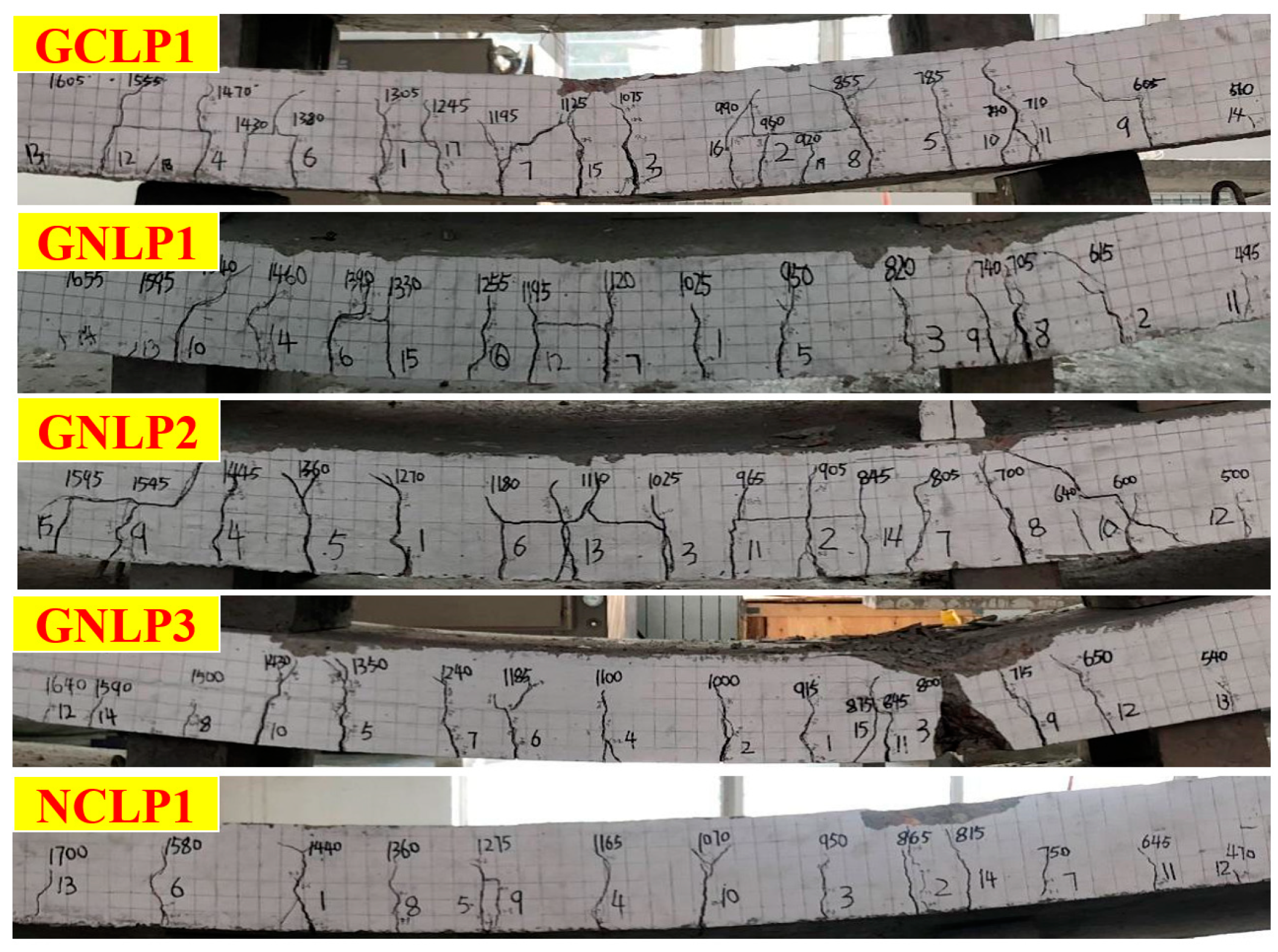


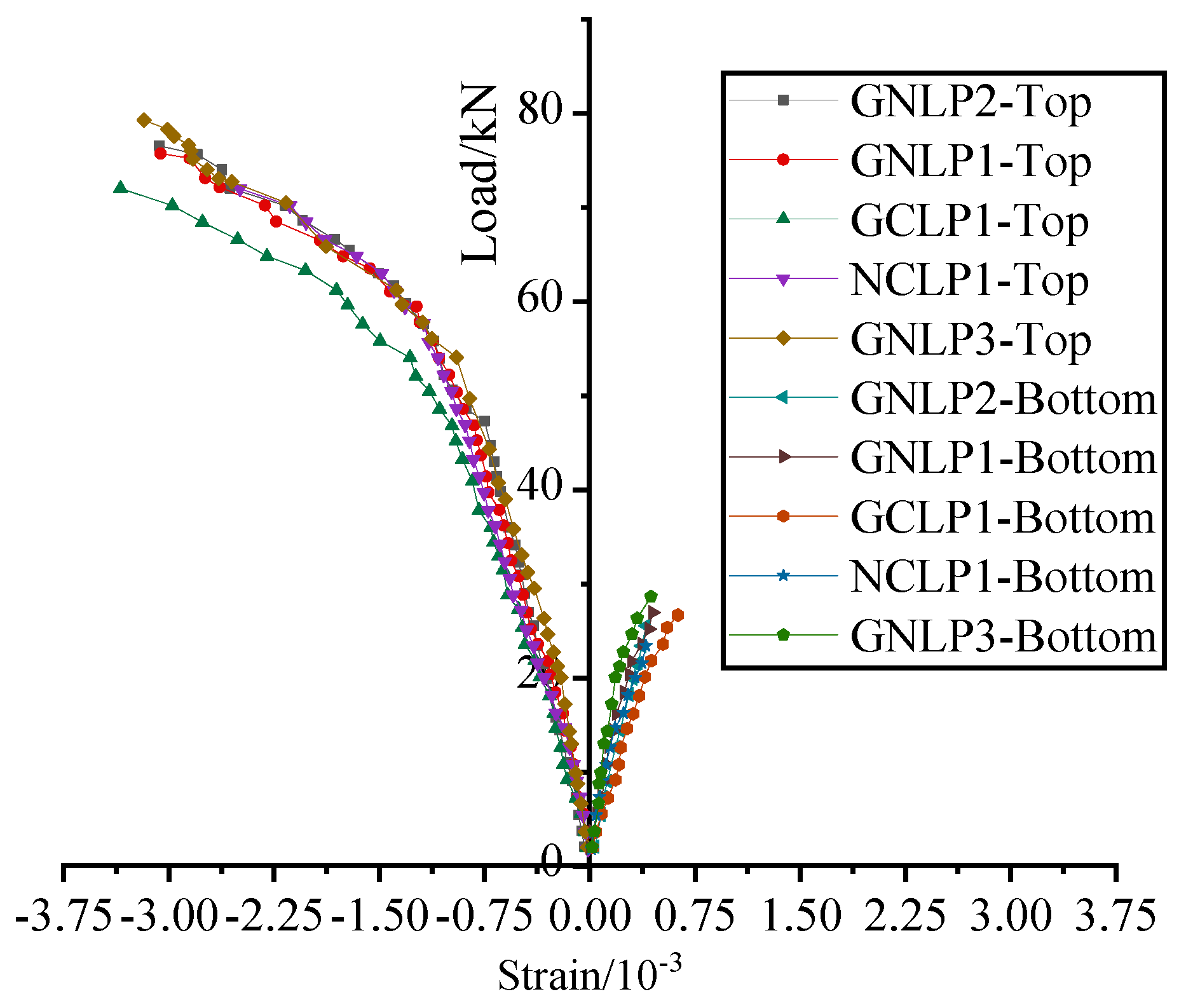
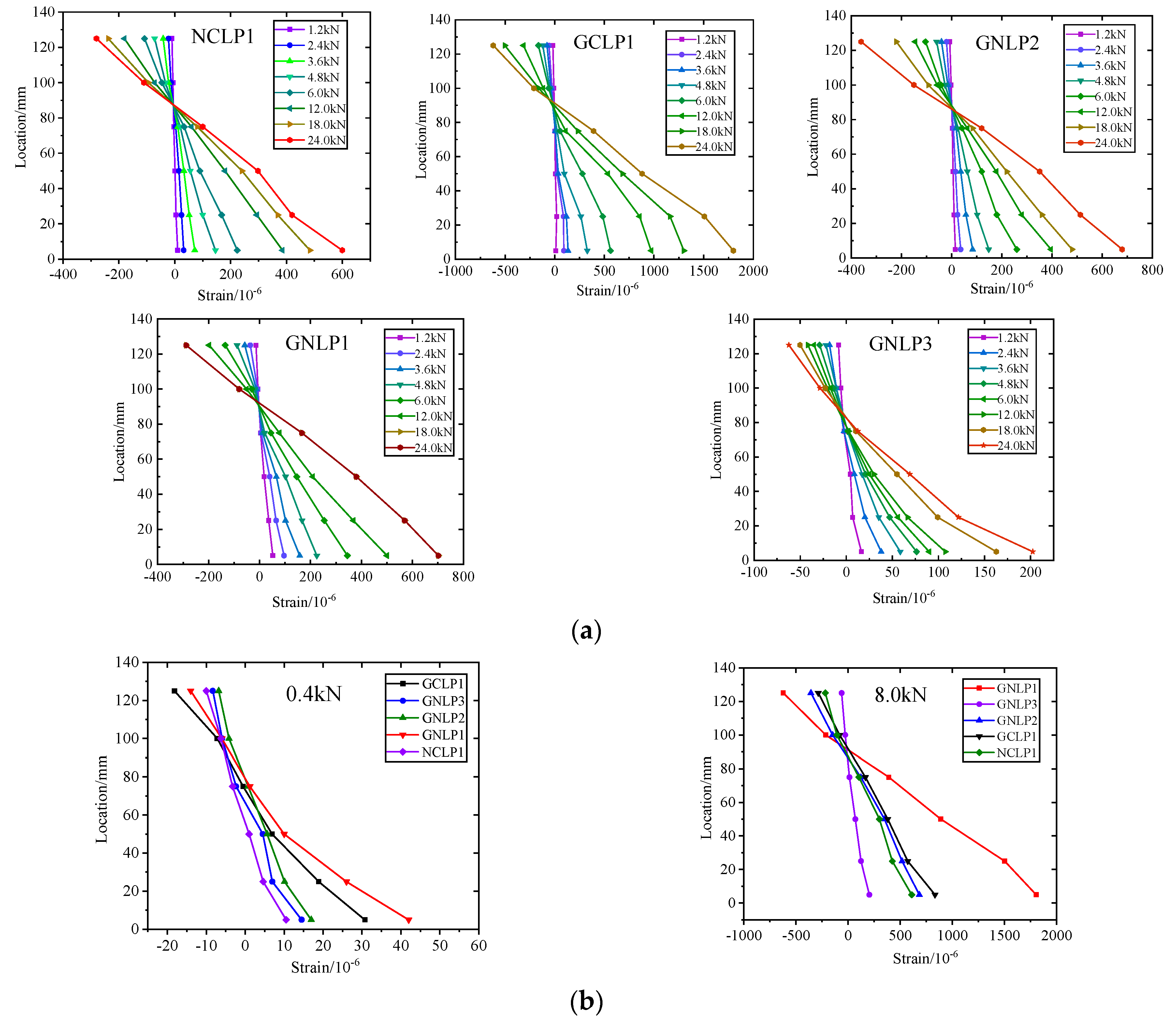
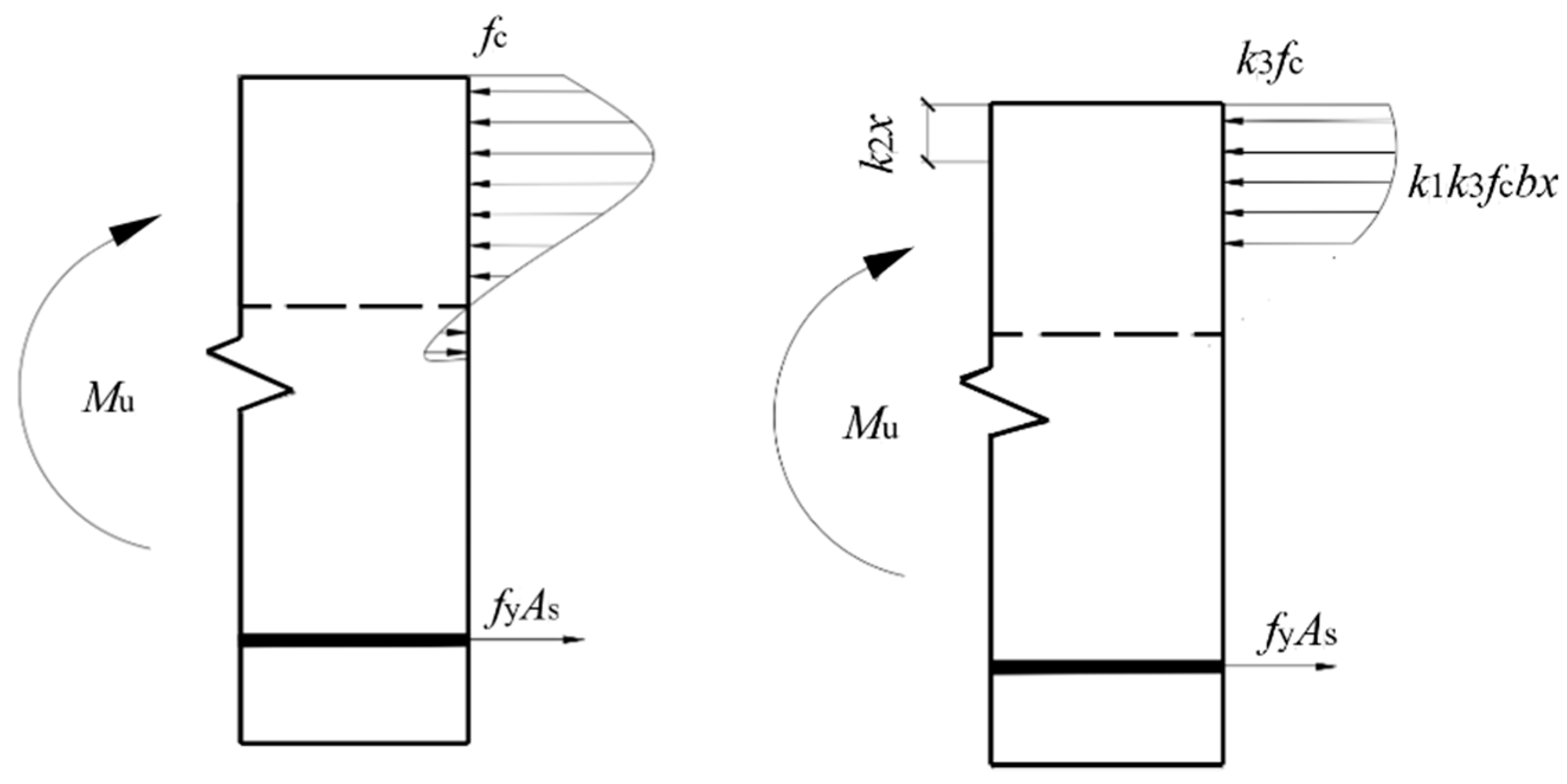


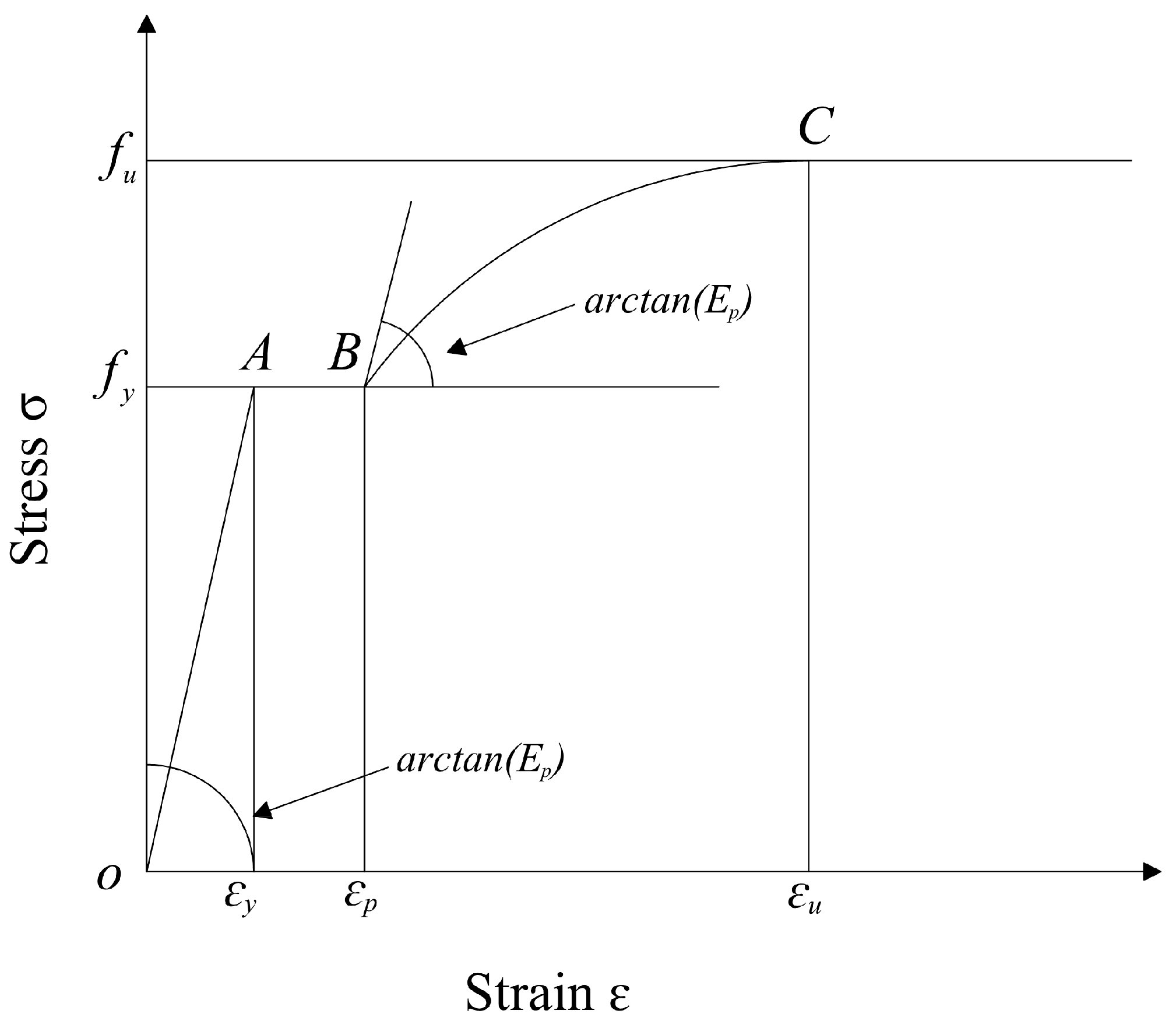
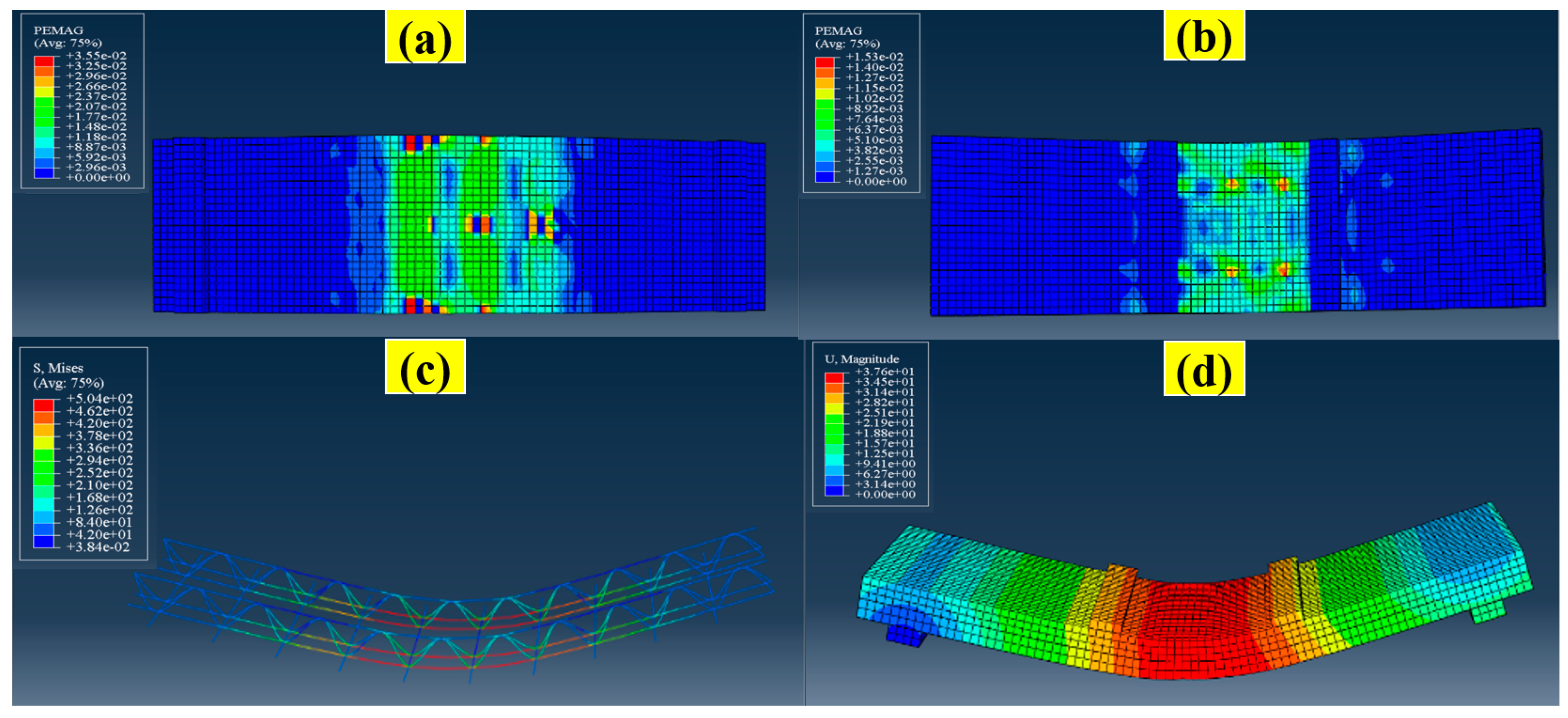
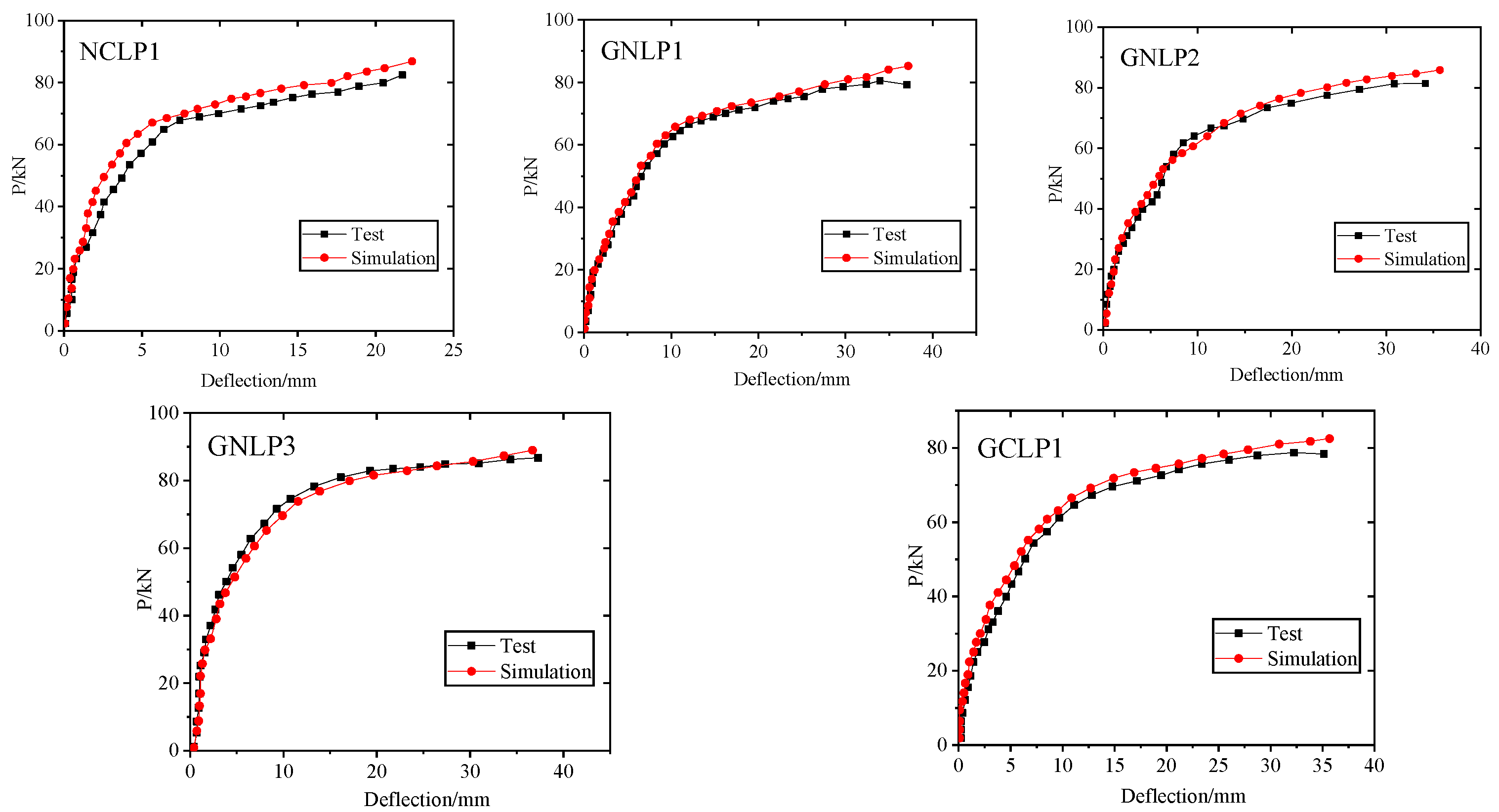
| Category | Grade | Specific Surface Area (m2/kg) | Density (kg/m3) | Setting Time (min) | Stability | MgO (%) | f-Cao (%) | SO3 (%) | 3 d Strength (MPa) | 28 d Strength (MPa) | |||
|---|---|---|---|---|---|---|---|---|---|---|---|---|---|
| Initial | Final | fcu | fcf | fcu | fcf | ||||||||
| OPC | 42.5 | 370 | 3020 | 245 | 308 | qualified | 2.8 | 0.83 | 2.9 | 27.9 | 6.23 | 51.8 | 9.6 |
| Fly ash | Ⅱ | 825 | 2347 | - | - | - | 1.56 | 6.07 | 1.04 | - | - | - | - |
| Character | Apparent Density (kg/m3) | Bulk Density (kg/m3) | Void Ratio (%) | Water Absorption Ratio (%) | Crushing Ratio (%) | ||
|---|---|---|---|---|---|---|---|
| Category | Loose Packing Density | Compact Stack Density | |||||
| NA | 2743 | 1520 | 1680 | 45.66 | 0.83 | 5.28 | |
| SCGA | 2276 | 1075 | 1220 | 52.77 | 7.55 | 21.20 | |
| Category | Cement | Fly Ash | Water | Water Reducer | Coarse Aggregate | Additional Water | Fine Aggregate | Compressive Strength (MPa) | Ec (GPa) | Slump (mm) |
|---|---|---|---|---|---|---|---|---|---|---|
| NAC(C30) | 320 | 80 | 184 | 3.3 | 870 | 0 | 950 | 34.2 | 17.3 | 50 |
| SCGAC(C30) | 320 | 80 | 175 | 6.6 | 820 | 82 | 924 | 30.8 | 14.5 | 20 |
| SCGAC(C35) | 360 | 90 | 178 | 7.3 | 800 | 80 | 866 | 35.9 | 15.8 | 25 |
| SCGAC(C40) | 376 | 94 | 171 | 7.4 | 769 | 71 | 769 | 41.1 | 17.4 | 35 |
| Specimen Number | Material and Grade of Precast Layer Concrete | Material and Grade of Cast-in-Place Layer Concrete | Transverse Distribution Reinforcement | Longitudinal Reinforcement | Number of Steel Trusses |
|---|---|---|---|---|---|
| NCLP1 | NAC(C30) | NAC(C30) | 8#200 | 8#225 | 2 |
| GCLP1 | SCGAC(C30) | SCGAC(C30) | 8#200 | 8#225 | 2 |
| GNLP1 | SCGAC(C30) | NAC(C30) | 8#200 | 8#225 | 2 |
| GNLP2 | SCGAC(C35) | NAC(C30) | 8#200 | 8#225 | 2 |
| GNLP3 | SCGAC(C40) | NAC(C30) | 8#200 | 8#225 | 2 |
| Specimen Number | Precast Slab Material | Cast-in-Place Layer Material | Lc (kN) | Lu (kN) | Du (mm) | Dut (mm) | W (mm) |
|---|---|---|---|---|---|---|---|
| NCLP1 | NAC(C30) | NAC(C30) | 24.3 | 81.1 | 20.46 | 10.1 | 4.0 |
| GCLP1 | SCGAC(C30) | SCGAC(C30) | 17.6 | 76.3 | 25.09 | 12.4 | 6.1 |
| GNLP1 | SCGAC(C30) | NAC(C30) | 20.6 | 77.4 | 26.24 | 13.5 | 6.0 |
| GNLP2 | SCGAC(C35) | NAC(C30) | 23.0 | 80.2 | 26.32 | 12.8 | 5.7 |
| GNLP3 | SCGAC(C40) | NAC(C30) | 26.2 | 84.1 | 20.50 | 11.5 | 3.8 |
| Specimen Number | Mcr,t (kN·m) | Mcr,c (kN·m) | Relative Error (%) |
|---|---|---|---|
| NCLP1 | 7.29 | 7.84 | 7.54 |
| GCLP1 | 5.28 | 5.45 | 3.22 |
| GNLP1 | 6.18 | 5.95 | 3.72 |
| GNLP2 | 6.90 | 6.82 | 1.16 |
| GNLP3 | 7.86 | 8.08 | 2.80 |
| Specimen Number | (kN·m) | (kN·m) | Relative Error/% |
|---|---|---|---|
| NCLP1 | 21.89 | 24.33 | 10.03 |
| GCLP1 | 20.32 | 22.89 | 11.23 |
| GNLP1 | 20.69 | 23.32 | 11.28 |
| GNLP2 | 21.94 | 24.06 | 8.81 |
| GNLP3 | 23.07 | 25.23 | 8.56 |
| Specimen Number | (kN·m) | (mm) | (mm) | Relative Error (%) |
|---|---|---|---|---|
| NCLP1 | 14.59 | 0.46 | 0.43 | 6.98 |
| GCLP1 | 14.59 | 0.67 | 0.69 | 2.90 |
| GNLP1 | 14.59 | 0.66 | 0.61 | 8.20 |
| GNLP2 | 14.59 | 0.55 | 0.50 | 10.00 |
| GNLP3 | 14.59 | 0.41 | 0.37 | 10.81 |
| Strength Grade | Fitting Equation | Accuracy |
|---|---|---|
| SCGAC(C30) | R2 = 0.997152 R2 = 0.958898 | |
| SCGAC(C35) | R2 = 0.999039 R2 = 0.987701 | |
| SCGAC(C40) | R2 = 0.999039 R2 = 0.987701 |
| Specimen Number | P1 (kN) | P2 (kN) | Relative Error (%) | D1 (mm) | D2 (mm) | Relative Error (%) |
|---|---|---|---|---|---|---|
| NCLP1 | 82.3 | 81.1 | 1.47 | 21.73 | 20.46 | 6.21 |
| GCLP1 | 78.5 | 76.3 | 2.88 | 27.54 | 25.09 | 9.76 |
| GNLP1 | 78.8 | 77.4 | 1.81 | 27.87 | 26.24 | 6.21 |
| GNLP2 | 83.3 | 80.2 | 3.87 | 27.09 | 26.32 | 2.93 |
| GNLP3 | 84.9 | 84.1 | 0.95 | 21.12 | 20.50 | 3.02 |
Disclaimer/Publisher’s Note: The statements, opinions and data contained in all publications are solely those of the individual author(s) and contributor(s) and not of MDPI and/or the editor(s). MDPI and/or the editor(s) disclaim responsibility for any injury to people or property resulting from any ideas, methods, instructions or products referred to in the content. |
© 2023 by the authors. Licensee MDPI, Basel, Switzerland. This article is an open access article distributed under the terms and conditions of the Creative Commons Attribution (CC BY) license (https://creativecommons.org/licenses/by/4.0/).
Share and Cite
Zhang, K.; Zhou, M.; Zhang, B.; Luan, C.; Li, C.; Liu, Y.; Gao, Y.; Yu, Y. Experimental and Numerical Study of the Flexural Performance of Spontaneous Combustion Gangue Coarse Aggregate Concrete Laminated Slab. Buildings 2023, 13, 1718. https://doi.org/10.3390/buildings13071718
Zhang K, Zhou M, Zhang B, Luan C, Li C, Liu Y, Gao Y, Yu Y. Experimental and Numerical Study of the Flexural Performance of Spontaneous Combustion Gangue Coarse Aggregate Concrete Laminated Slab. Buildings. 2023; 13(7):1718. https://doi.org/10.3390/buildings13071718
Chicago/Turabian StyleZhang, Kai, Mei Zhou, Boqun Zhang, Congqi Luan, Chao Li, Yan Liu, Yue Gao, and Yanfu Yu. 2023. "Experimental and Numerical Study of the Flexural Performance of Spontaneous Combustion Gangue Coarse Aggregate Concrete Laminated Slab" Buildings 13, no. 7: 1718. https://doi.org/10.3390/buildings13071718
APA StyleZhang, K., Zhou, M., Zhang, B., Luan, C., Li, C., Liu, Y., Gao, Y., & Yu, Y. (2023). Experimental and Numerical Study of the Flexural Performance of Spontaneous Combustion Gangue Coarse Aggregate Concrete Laminated Slab. Buildings, 13(7), 1718. https://doi.org/10.3390/buildings13071718





